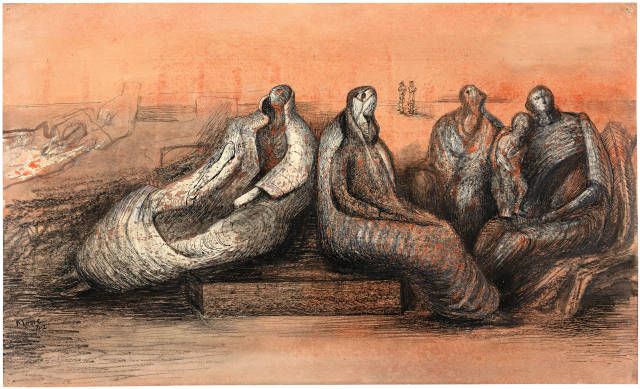- EN
Log in
- Live Auctions
- Past auctions
- More
- Gallery
- Art Dealing
- Publishing
- Kornfeld today
- The Story of Kornfeld
- Information





Sale time 13-09-2024,
about 14:10 h (CET)
(+/- 30 min)
1942
Indian ink and charcoal on wove paper over watercolour, partially heightened with white
33.3x55.8 cm
Signed and dated in ink by the artist lower left "Moore / 42"
Intended for the catalogue raisonné of drawings of the "Henry Moore Foundation" with the work number "HMF 2100A". Confirmation, dated 11 November 1993, is available
Private collection Switzerland
Auction Galerie Kornfeld, Bern, 24 June 1994, lot 96
Gallery Kornfeld, Bern, from there to
The Eberhard W. Kornfeld Collection, Bern, with the collector's stamp on the reverse, Lugt 913b
Martigny 1989, Fondation Pierre Gianadda, Henry Moore, p. 146, ill.
Fresh in colour and in good condition. With nail holes in the corners. Right margin with neatly backed and retouched paper irregularities. With remnants of museum mounting all around on the reverse
With the outbreak of the Second World War, Henry Moore gave up his position as Head of Sculpture at the Chelsea School of Art. He had been asked by art historian Kenneth Clark, the director of the National Gallery in London, to take part in the War Art Initiative during the Second World War. Moore was initially reluctant, but eventually received commissions as a "War Artist". Unlike his friends Ben Nicholson and Barbara Hepworth, who had moved from London to St Ives shortly after the outbreak of war, Moore kept his studio in Hampstead and, like most Londoners, tried to maintain as normal a life as possible. In the summer of 1940, however, the air raids across the country and on London in particular became increasingly intense. Many Londoners therefore used the the Underground as temporary accommodation. On 11 September 1940, Moore and his wife were returning from a dinner with friends in the city centre. While travelling on the Underground, the sirens sounded and when they reached Belsize Park, Moore was fascinated by the large number of people seeking shelter on the platforms. Moore made his first drawing on the subject the next day and then returned several times to study the crowd of people seeking shelter. This resulted in the so-called "Shelter Drawings", which would make Moore internationally famous. In the USA in particular, they were regarded as metaphors for the stoic resistance of the English during the war. After his flat in Hampstead, London, was hit by a bomb, he moved with his wife Irina to a farmhouse called "Hoglands" in the small village of Perry Green near Much Hadham, Hertfordshire, where he continued the series.
The figures are composed with virtuosity, but have a shadowy quality. In an impressive, vivid mixed media technique, the sculptor created literally frozen situations of human existence; metaphors of perseverance, waiting and hope. The present drawing is certainly one of the particularly elaborate and large-format works of the group.
1942
Tusche und Kohle über mit Aquarell grundiertem Velin, stellenweise weiss gehöht
33,3x55,8 cm
Unten links vom Künstler in Tusche signiert und datiert "Moore / 42"
Vorgesehen für das Werkverzeichnis der Zeichnungen der "Henry Moore Foundation" mit der Werknummer "HMF 2100A". Bestätigung, datiert vom 11. November 1993, liegt bei
Privatsammlung Schweiz
Auktion Galerie Kornfeld, Bern, 24. Juni 1994, Los 96
Galerie Kornfeld, Bern, von dort an
Slg. Eberhard W. Kornfeld, Bern, rückseitig mit dem Sammlerstempel, Lugt 913b
Martigny 1989, Fondation Pierre Gianadda, Henry Moore,
Farbfrisch und in guter Erhaltung. In den Ecken mit Reissnagellöchern. Am rechten Rand mit sauber hinterlegten und retuschierten Papierunregelmässigkeiten. Rückseitig mit umlaufenden Resten einer Museumsmontierung
Mit dem Ausbruch des Zweiten Weltkriegs gab Henry Moore seine Tätigkeit als Leiter des Bereichs Bildhauerei an der Chelsea School of Art auf. Er war vom Kunsthistoriker Kenneth Clark, dem Direktor der National Gallery in London, gebeten worden, sich während des Zweiten Weltkriegs an der Kriegskünstlerinitiative zu beteiligen. Moore war zuerst zurückhaltend, erhielt aber schliesslich Aufträge als "War Artist". Im Gegensatz zu seinen Freunden Ben Nicholson und Barbara Hepworth, die kurz nach Kriegsausbruch von London nach St. Ives gezogen waren, behielt Moore sein Atelier in Hampstead und versuchte, wie die meisten Londoner, den Anschein eines möglichst normalen Lebens aufrechtzuerhalten. Im Sommer 1940 wurden die Luftangriffe im ganzen Land und insbesondere auf London jedoch immer heftiger. Viele Londoner nutzten daher die tiefer gelegenen Stationen des U-Bahnnetzes als provisorische Unterkünfte. Am 11. September 1940 kehrten Moore und seine Frau von einem Abendessen mit Freunden im Stadtzentrum zurück. Während der Fahrt mit der U-Bahn ertönten die Sirenen, und als sie Belsize Park erreichten, war Moore fasziniert von der grossen Zahl von Menschen, die auf den Bahnsteigen Schutz suchten. Moore fertigte am nächsten Tag seine erste Zeichnung zu diesem Thema an und kehrte dann mehrmals zurück, um die versammelten, Schutz suchenden Menschen zu studieren. Daraus entstanden die sogenannten "Shelter Drawings", die Moore international bekannt machen sollten. Vor allem in den USA galten sie als Metaphern für den stoischen Widerstand der Engländer während des Krieges. Nachdem seine Wohnung im Londoner Stadtteil Hampstead von einer Bombe getroffen worden war, zog er mit seiner Frau Irina in ein Bauernhaus namens "Hoglands" im kleinen Dorf Perry Green bei Much Hadham, Hertfordshire, wo er die Serie fortsetzte.
Die Figuren sind virtuos, aber schemenhaft komponiert. In einer eindrücklichen, plastisch wirkenden Mischtechnik schuf der Bildhauer förmlich eingefrorene Situationen menschlicher Existenz; Metaphern des Ausharrens, Wartens und Hoffens. Das vorliegende Blatt gehört sicherlich zu den besonders ausgearbeiteten und grossformatigen Werken der Gruppe.
| Switzerland | CHF | 130 |
| Europe | CHF | 230 |
| Overseas | CHF | 290 |






